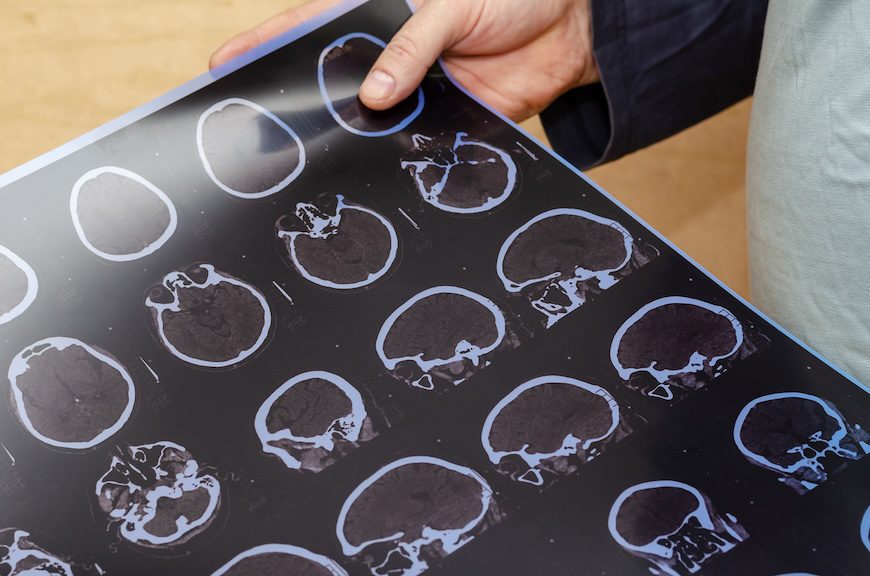Heather Anderson, a professional Australian football player, is the first female athlete to be diagnosed with chronic traumatic encephalopathy, or CTE.
Analysis and Findings
Anderson died by suicide in 2022 at the age of 28. In a letter to the editor in the journal Acta Neuropathologica, Australian researchers described how they used immunohistochemistry and Garvey silver staining techniques to analyze Anderson’s brain tissue, which was donated by her family to the Australian Sports Brain Bank upon her death.
In this case, immunohistochemistry involves the identification of antibodies specifically designed to bind to certain proteins, including tau protein. Garvey silver staining highlights neurofibrillary tangles, the abnormal clumps of tau protein that are characteristic of CTE. It allows for the visualization of the tau pathology in the brain tissue sections.
Military-Versus Sports-Related TBI
Dog Walking Linked to Surprisingly High Risk of TBI
The analysis revealed a small venous angioma in the white matter of the right frontal lobe. It also discovered the presence of hyperphosphorylated tau protein in three areas of the brain, primarily around blood vessels in the folds of the cortex. Each lesion measured approximately 2-3 mm in cross section.
Some areas revealed the presence of mature neurofibrillary tangles, which are a hallmark of CTE. Other parts of the brain showed lesser amounts of the tau protein. The analysis didn’t detect any other significant abnormalities related to CTE or additional brain disease. Taken together, these findings confirmed a diagnosis of early-stage CTE based on current diagnostic criteria, the authors concluded.
“As the representation of women in professional contact sports is growing, it seems likely that more C.T.E. cases will be identified in female athletes,” the authors said in their letter. “Given females’ greater susceptibility to concussion, there is an urgent need to recognize the risks, and to institute strategies and policies to minimize traumatic brain injuries in increasingly popular female contact sports.”
CTE Pathology
CTE is a degenerative brain disease that can only be studied after the death of a subject. The buildup of a protein called hyperphosphorylated tau in the brain, particularly around blood vessels in the folds of the outer layer, characterizes the condition. Prior exposure to traumatic brain injuries, such as concussions or repetitive hits to the head, represents the only known risk factor for CTE.
Researchers have most commonly found CTE in the brains of deceased athletes who participated in contact sports like football and boxing. They have also observed CTE in individuals who experienced repetitive head trauma through other means, such as seizures, violent incidents, or military service.
CTE risk in sports seems to be related to the length of an athlete’s career and the number of brain injuries they experience. Men have historically dominated contact sports, where head injuries are more common. However, studies suggest that females may be more susceptible to sports-related concussions than males, even when accounting for participation rates. So far, there have been only a few reported cases of CTE in females. As the letter suggested, Anderson is the first-known female professional athlete to be diagnosed with CTE.
Medical History and Advocacy
Anderson was an avid and talented athlete who began playing Australian rules football at the age of five. She went on to play for Sale City Football Club, Belconnen Cats, and the Canberra Demons. The Adelaide Crows drafted her in 2017, and she played in their inaugural AFLW season. She also served her country as a medic in the 1st Close Health Battalion.
Anderson’s medical history indicated one diagnosed concussion and four suspected, but not formally diagnosed, concussions, as reported by her family. Additionally, she served in the military for nine years and engaged in amateur martial arts for three years. She did not seek medical attention for concussions during that time. She retired from professional football at the end of the 2017 season due to a shoulder injury.
“Heather was a daughter, a sister, a granddaughter, a niece and a cousin. The sadness and loss our family is experiencing is palpable,” her family said in a statement provided to news.com.au at the time of her death.
Anderson was also a mental health advocate for the military. “My goal is to raise awareness of the prevalence of mental health issues within the military to the wider community, with the hope to diminish the stigma surrounding it, as well as raise funds to support individuals with their recovery,” she said in 2017.
_____________________________________________________________________________
If you or someone you know need mental health assistance, please call the national suicide hotline, 988, or visit Suicide & Crisis Lifeline website.



